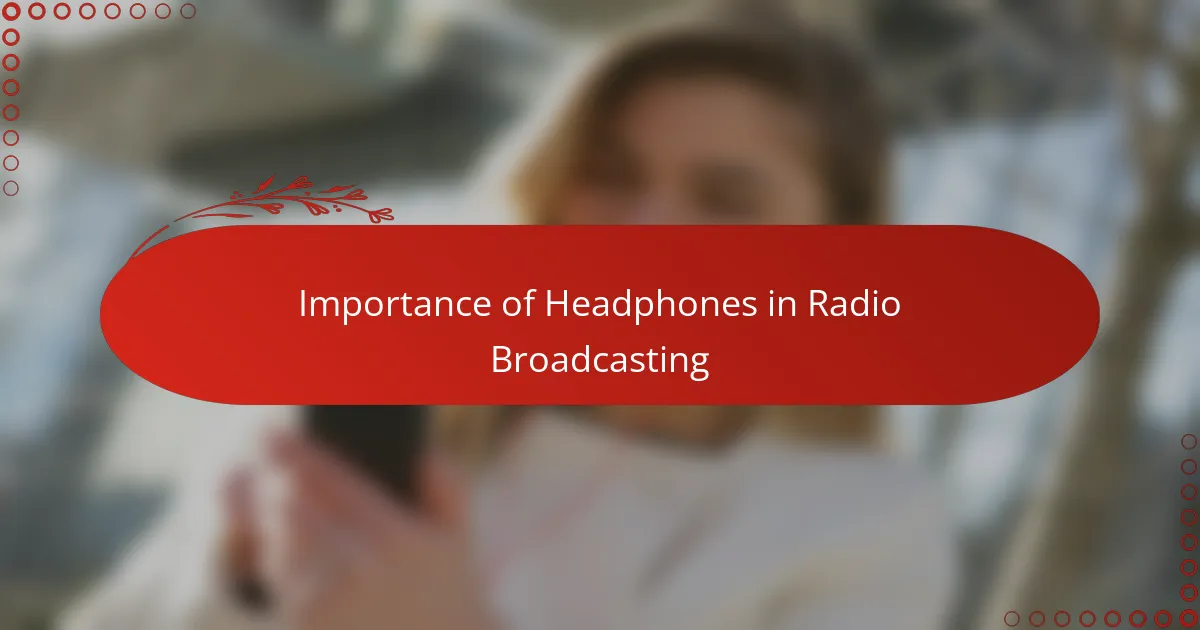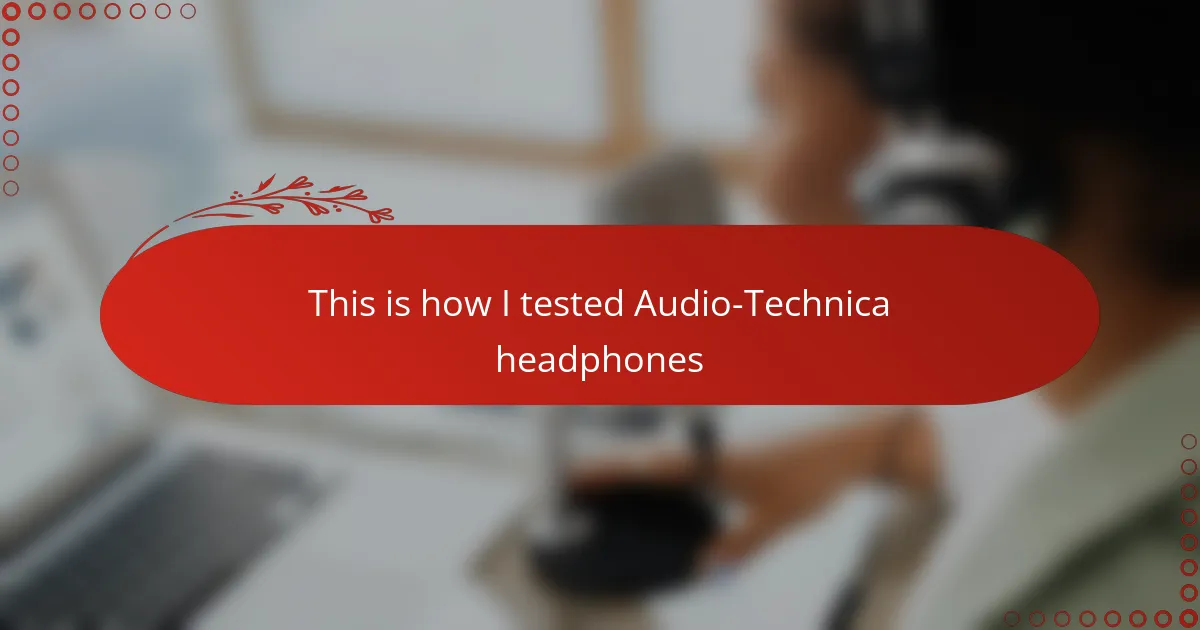Key takeaways
- Audio-Technica headphones are renowned for their comfort and durability, making them ideal for extended use in radio broadcasting.
- Key features for broadcasting headphones include sound isolation, clarity of audio reproduction, and comfort, all crucial for effective performance.
- The testing process emphasizes sound accuracy, comfort during long sessions, and noise isolation to ensure a professional broadcasting experience.
- Personal experience highlights the natural sound delivery and effective noise isolation of Audio-Technica headphones, enhancing focus and reducing distractions during broadcasts.

Overview of Audio-Technica Headphones
Audio-Technica headphones have long been a favorite in the audio world, especially for those of us in radio broadcasting who demand clarity and precision. From my experience, their design strikes a rare balance between comfort and durability, which matters a lot during those long recording sessions. Have you ever tried headphones that felt great at first but became uncomfortable after an hour? With Audio-Technica, that’s rarely an issue.
What impresses me most is the consistent audio quality these headphones deliver. Whether I’m monitoring a live broadcast or editing pre-recorded content, the sound remains clear with a natural balance across lows, mids, and highs. This reliability makes a huge difference when you’re trying to catch every nuance in a voice or background sound.
Another aspect I appreciate is the variety within the Audio-Technica lineup. They offer everything from open-back models that give a spacious feel to closed-back options perfect for isolating noise. This variety means there’s likely a pair tailored to your specific needs, whether you’re mixing a podcast or handling field recordings. Have you explored their range yet, or do you find yourself sticking to one go-to model?

Importance of Headphones in Radio Broadcasting
Headphones are absolutely essential in radio broadcasting because they act as our direct link to what listeners will eventually hear. I’ve found that without reliable headphones, it’s easy to miss subtle audio details that can make or break a show. Have you ever caught a background noise or vocal crackle only after it was too late? Good headphones help prevent that.
Another thing I’ve noticed is how headphones create an intimate workspace, almost like a personal bubble amid the chaos of a busy studio. They allow me to focus on every vocal inflection and music cue without distraction, which is crucial when timing and clarity are everything. When the broadcast is live, that connection becomes even more vital, doesn’t it?
Finally, I can’t overstate how much comfort factors into performance. Wearing headphones for hours can become physically draining if they’re poorly designed. I’ve had my share of headaches and ear fatigue from lesser sets, but with the right pair, you barely notice them—even during marathon sessions. That comfort directly influences how well you perform behind the mic.

Key Features for Broadcasting Headphones
One feature I always prioritize in broadcasting headphones is sound isolation. In a noisy studio environment, being able to block out distractions lets me zero in on the content without constantly adjusting volume or missing cues. Have you ever struggled to focus because background chatter creeps in? That’s where effective noise isolation, often found in closed-back designs, makes all the difference.
Another key aspect is the clarity of the audio reproduction. From my experience, headphones that deliver a flat and balanced sound help tremendously in catching subtle vocal nuances and avoiding overemphasis on certain frequencies. When I’m editing or monitoring live, I rely on headphones that don’t color the sound, ensuring what I hear is exactly what the audience will get.
Comfort is the silent game-changer for me. It’s easy to overlook until you’re halfway through a long broadcast and notice your ears aching or the headband digging in. I’ve found that breathable ear pads and adjustable headbands not only enhance comfort but also keep me focused longer. Isn’t it frustrating when your gear distracts you from doing your best work? Good broadcasting headphones minimize that struggle.

Testing Criteria for Audio-Technica Headphones
When I test Audio-Technica headphones, the first criterion I focus on is sound accuracy. It’s crucial to hear every detail precisely as it is—no exaggeration of bass or treble—since that’s what ensures my broadcasts sound professional. Have you ever struggled with headphones that make voices sound unnatural? Those just don’t cut it in the studio.
Another critical factor for me is comfort during extended use. I remember one marathon editing session where my usual headphones started to pinch my ears painfully after just an hour. With Audio-Technica, I pay close attention to how breathable the ear pads feel and whether the headband pressure stays gentle enough for those long hours. It makes a world of difference when fatigue doesn’t creep in.
Lastly, I always check the build and noise isolation quality. In a busy studio, every bit of external noise blocked means fewer distractions and smoother workflow. Do you find yourself constantly tweaking the volume to overcome background noise? I know I do, so testing how well these headphones isolate sound helps me pick the right model for the job.

Step-by-Step Testing Process
First, I started by setting up a quiet environment to really put the Audio-Technica headphones through their paces. I played a variety of audio samples—podcast recordings, live broadcast clips, and music with complex layers—to see how accurately each sound was reproduced. Have you ever noticed how some headphones make vocals sound flat or drown out subtle background details? With these, I was keen to catch every nuance clearly.
Next, I wore the headphones for several hours during actual broadcast sessions to test comfort and durability. It wasn’t just about short-term fits but how they felt after extended use—did the headband dig in, or did the ear pads breathe well enough to avoid sweating? I remember one afternoon when I almost forgot I had them on because they felt that comfortable, which says a lot when you’re used to that nagging pressure in other models.
Finally, I evaluated the noise isolation by working in a typically busy studio environment with plenty of background chatter and equipment hum. I wanted to see if the headphones could keep distractions at bay without pushing volume to unhealthy levels. Isn’t it frustrating when you have to constantly adjust volume just to drown out ambient noise? These tests helped me judge which models would truly excel in real-world radio broadcasting conditions.

Personal Experience with Audio-Technica Tests
When I first slipped on the Audio-Technica headphones, I was honestly surprised by how natural the sound felt—like the voices and music were unfolding right in front of me without any artificial boost. Have you ever tried a pair that made everything sound either dull or overly punchy? This wasn’t one of those times. It felt like the headphones were really respecting the original recording, which for me is crucial when editing broadcast content.
During one particularly long session, I noticed something that caught me off guard: I barely felt the headphones on my head, even after wearing them for hours. Usually, after a few broadcasts, my ears start to feel sore or the clamp pressure gives me a headache. But these managed to stay comfortable without sacrificing sound quality. That comfort really changed how focused I could stay behind the mic.
I also found myself appreciating the way these headphones handled the noisy studio environment. Instead of constantly battling background hums and chatter, I could zero in on the audio without cranking up the volume. Ever been in that awkward spot where you’re constantly adjusting volume levels just to block noise? These headphones made that struggle far less frequent, which gave me more peace of mind during live broadcasts.
